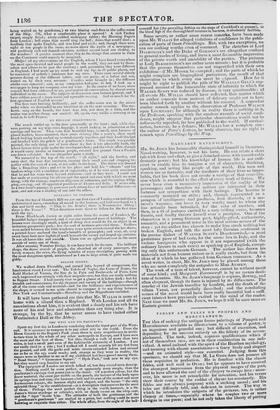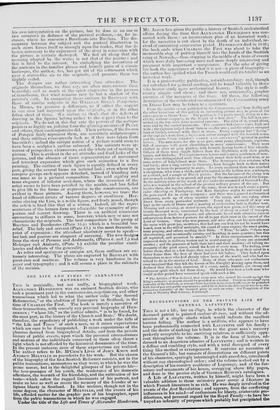FABLES AND TALES ON POMPEII AND HERCULANEUM.
THE idea of making the antique fresco paintings of Pompeii and Herculaneum available as illustrations to a volume of poetry, is an ingenious and graceful one; but difficult of execution, and depending for its success entirely on ,the felicity of its accom- plishment. The task, indeed, requires qualifications which if not of themselves rare, are so in their combination in one indi- vidual. A mind imbued with the spirit of the Heathen mythology, and teeming with classic associations—a fancy lively and elegant —and an animated style—are essential. Judging from this specimen, we should say that M. LE GROS does not possess all these requisites in perfection. He is familiar with the classic fables, and well read in OVID; but he appears to have received the strongest impressions from the physical images of the poet, and to have allowed the soul of the allegory to escapa hint : more- over, his muse is not remarkable for invention, and his verses steer their course by the rudder of rhyme too constantly. His fables are not always pregnant with a striking moral; and his tales are diffusely told, and deficient in interest. The way in which he introduces the subjects of the pictures, too, is rather clumsy at times,—especially where he couples two or more designs in one poem; and he not only takes the liberty of putting
his own interpretation on the picture, but he does so on one or two cccasiors in defiance of the pictural evidence,—as, for in- stance, where he converts a Bacchante into Bacchus. The dis- crepancy between the subject and the poetical illustration in such cases forces itself so strongly upon the reader, that the il- lusion necessary to the enjoyment of the story in connexion with the picture is entirely destroyed. We feel all along that the meaning adopted by the writer is not that of the painter ; and this is fatal to the interest. In embodying the inventions of the ancients in the familiar phrase and homely guise of a classic burlesque, the author, toe, has got rid of the refinement which gave a statue-like air to the originals, and presents them too slightly veiled.
The designs are rather interesting than attractive. The originals themselves, we dare sty, arc often more curious than beautiful ; and so much of the spirit evaporates in the process of transfusion, that what remains may be but a shadow of the painter's e ork. In comparing these outlines by BROMLEY with those of similar subjects in Sir WILLIAM GELL'S 1),,ntpriana by MOSES, we perceive a difference, as if either the copyist in one case had improved upon the orlgieals, or in the other fallen short of them. iVe incline to think that the &forts of drawing in the figures belong rather to the copyist than to the originals. We do not in this day rate tha powers of the antique painters so highly as, judging from the glowing accounts of Pi. t NY and others, their contemporaries did. Their pictures, if the frescos of Pompeii fairly represent them, are essentially sculpturesque; and these outlines consequently look as if they were taken from bas-reliefs: indeed the antique notion of a picture would seem to have been a sculptor's outline coloured. The ancients were ig- norant of perspective, chiaroscuro, and the whole art of making a picture. This is evident in the set attitudes and fixed looks of the persons, and the absence of those representations of movement and transient expression which give such animation to a fine painting. The outline of each figure is equally defined in every part, giving the several forms an isolated look ; even where they compose groups each appears detached, instead of blending into one mass as in a pictural composition. The cold rigidity and tame elegance of inferior sculpture, where the invention of the artist seems to have been petrified by the marble, and has failed to give life to the forms or expression to the countenances, are evident in these pictures. Among them, however, we trace the hand of different artists of various degrees of excellence. Her- cules slay ing the Lion, is a noble figure, and finely posed, though the action is fixed like that of a statue. Indeed, all the repre- sentations of the human form are admirable for symmetry of pro- portion and correct drawing. There is an artificial constraint amounting to stiffness in some, however, which may or may not characterize the originals. The best composition is the group of
Bacchus and Bacchantes (Plate 15.); which is a beautiful has- relief. The lady and servant (Plate 13.) is the most dramatic in point of expression : the attendant absolutely seems to speak— her look and posture arc eloquent of meaning. The two designs from the story of Perseus and Andromeda, (Plates 6. and 7.) and Meleager and Atalanta, (Plate 1.) exhibit the peculiar excel- lencies and defects of the generality.
As relics and specimens of antique art, these outlines are ex- tremely interesting. The plates are engraved by BROMLEY with
great care and neatness. The volume is very handsome in its paper and typography ; and it will secure a place in the cabinets of the curious.



























 Previous page
Previous page